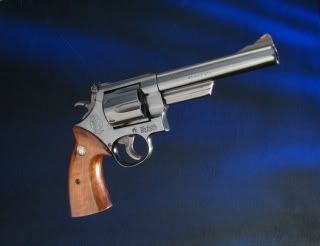

Trench raiding was a tactic developed by the British, although the French and Germans quickly caught on. The weapons used during trench raids were famously gruesome with some men using maces, clubs and knives. However, the most popular weapon was the pistol, closely followed by bombs or grenades.
In late 1916 Captain Arthur Pritchard, who had been serving with the Royal Berkshire Regiment in Flanders since 1915, developed the Pritchard Revolver Bayonet for the British Army’s standard issue pistol the Webley Mk VI. The idea behind the weapon was that in the close-quarter hand to hand fighting frequently experienced during a trench raid a man equipped with a Webley might not have time to reload. Although the Webley was remarkably quick to reload – especially with speed loaders (pouch next to the officer’s holster image #2), it was thought that in a tight situation a short stabbing blade could be extremely useful.

British Trench Raiding Weapons c.1916 (source)
The Pritchard bayonet was a shortened French Gras rifle bayonet adapted to attach to the pistol’s barrel with the the cross guard behind the foresight with the base sitting against the frame, around the revolver’s cylinder cam, cam lever and joint/hinge pin screw. The Gras blade was shortened to roughly 8 inches making the weapon’s overall length about 17 inches.
Pritchard initially brought his design before the famous sword and blade makers Wilkinson’s Sword Company however after making a prototype they passed on the idea. It was the Birmingham gunmakers W.W. Greener which took on Captain Pritchard’s design believing their may be a real market for the weapon both privately and possibly as a wider army contract.

1874 Gras Rifle bayonet (source)
Greener produced two variants of the bayonet, one with a steel hilt and another more commonly seen variant with a brass grip (see above). The bayonet was undoubtedly a fearsome looking weapon which would have certainly had a psychological and possibly practical impact on any German soldier unlucky enough to come face to face with one (see the artist’s impression above, image #2).
The Pritchard-Greener Revolver Bayonet was never widely manufactured and was not a commercial success. Exactly why is unclear although practically speaking the blade would have made the revolver muzzle heavy. It is estimated that as few as 200 were actually produced. There is no direct evidence to suggest any ever reached the Western Front or were used.
The demand created by arms and militaria collectors over the last 30 years means that thousands of copies and replica Pritchard Bayonets have been manufactured.
Sources:
Image One Source
Image Two Source
Image Three Source
The Webley Service Revolver, R. Maze, (2012)
via historicalfirearms




